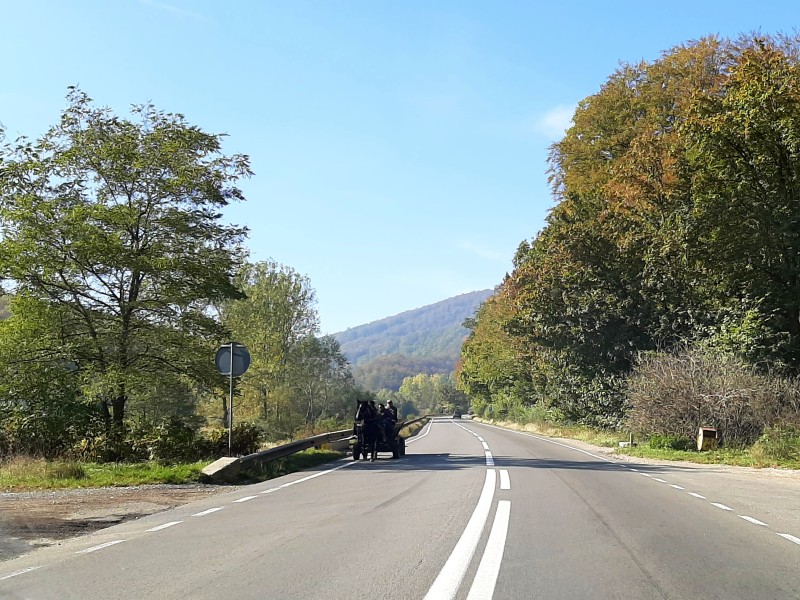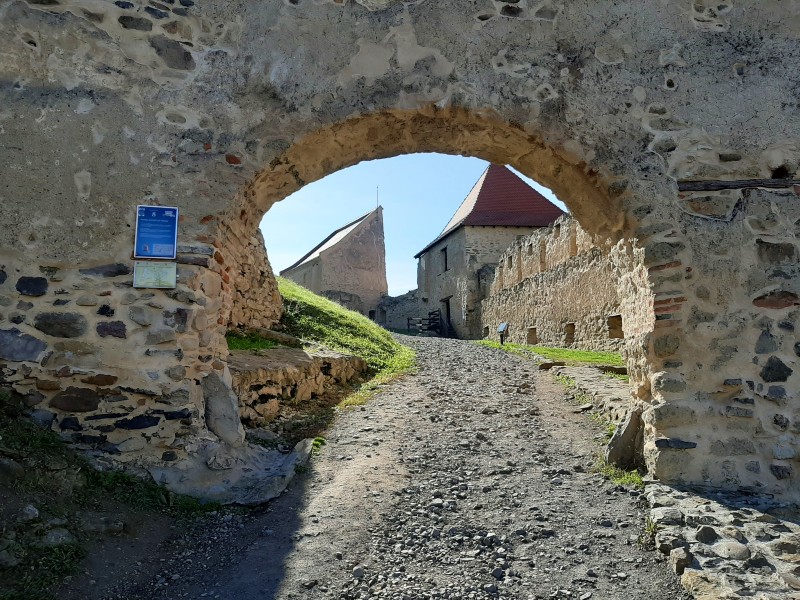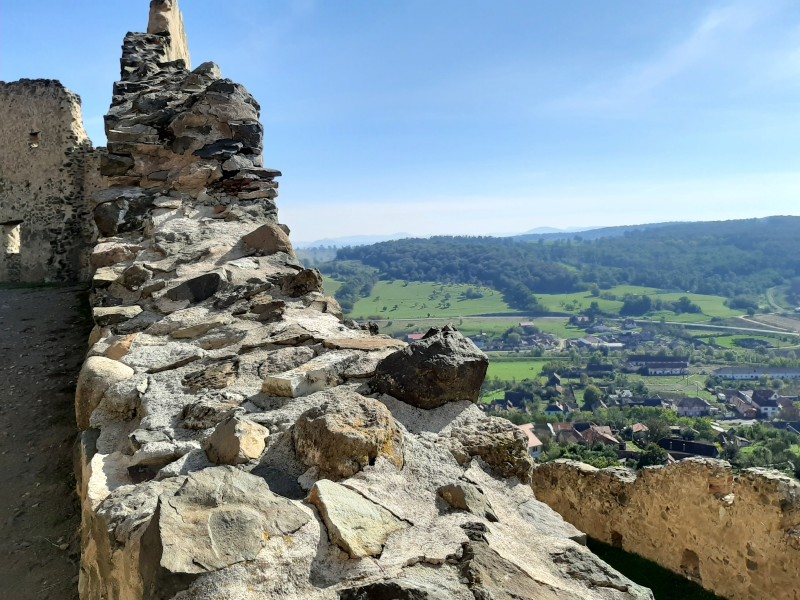A Visit to Rupea Fortress
In this destination guide we will visit the town and fortress of Rupea in Brașov County, Romania.
On the road
Having visited the castle and fortified church at Feldioara, I drove further north on the main provincial road towards Rupea.
This road, the DN13, links Brașov with Sighișoara. As both Brașov and Sighișoara are among the most beautiful and interesting cities to visit in Transylvania, you are likely to take this road if you make an extended tour of this beautiful Romanian region.
The DN13 is a good quality road although given the fact that it’s a single carriageway for most of the distance you might find yourself stuck behind slower traffic on uphill or twisty stretches.
Fortunately, traffic was light today and after a couple of minutes of driving the morning fog even started to disappear, giving way to beautiful blue skies.




Rupea
The town of Rupea is located roughly halfway between Brașov and Sighișoara and makes for a nice stop on the way. The reason why immediately becomes clear when you approach the town.
From the DN13, you can clearly see Rupea’s imposing hilltop fortress looming high above the town. It’s an impressive sight from a distance and it certainly invites you to pay the fortress a visit.
A brand new access road leads from the DN13 to a large parking lot in front of the fortress where you can park your car if you want to make a visit to this historical sight.
Although Rupea has a train station on the main Brașov to Sighișoara railway line, it’s located far out of town and thus requires an additional taxi ride to cover the distance to the fortress. Driving yourself definitely is the way to go here!





Visiting Rupea Fortress
Rupea Fortress (called ‘Cetatea Rupea’ in Romanian) charges a 15 RON entrance fee to adults, which more or less equals 3 euro.
You buy a ticket from a small ticket booth outside the main gate, through which you enter the fortress.
It were the Dacians who first built a fortress on this 120 metres high basalt cliff, although archaeological evidence has showed that the place was already inhabited in the Palaeolithic era.
When the Romans conquered the Dacian fortress they built their own ‘castrum’ (fort) on top which they called ‘Rupes’, the Latin name for rock or cliff. The current name of Rupea is derived from the Latin word Rupes.
Much of what you see now is from the Medieval era as in the 14th Century the fortress was rebuilt and expanded by the Transylvanian Saxons.




Renovation
You don’t need a trained eye to see that some parts of the fortress (such as the entrance gate and outer wall) are neatly restored while some other parts of the walls look like they haven’t been touched since centuries.
This renovation took place between 2010 and 2013 and was generally quite successful as it turned the fortress from a crumbling, forgotten sight into a tourist attraction.
It’s certainly interesting to compare some old pictures of Rupea Fortress before the renovation with how it looks these days.




Walls, towers and enclosures
Rupea Fortress basically consists out of an upper fortress, middle fortress and a lower fortress – all of them being divided by several interior gates and walls.
The lower fortress is the oldest as it was only built in the 18th Century, while the upper fortress is by far the oldest. It was on this spot where the old Dacian fortress of Rumidava once stood.
In total, Rupea Fortress has four enclosures which are reinforced by several polygonal towers.
From the eastern fortress walls you have some panoramic views over the town of Rupea and the hilly Transylvanian landscape.





Upper fortress
Apart from the stone walls and a couple of towers there isn’t actually much to see inside Rupea Fortress.
The few towers which are open to the public are for example completely empty, although there are some information signs scattered around the premises which tell you more about the history of the fortress.
It’s however a scenic walk from the main entrance all the way to the highest keep in the upper fortress.
Even though that small upper tower is also closed for the public, you have some good views down over the different enclosures, outer walls and the valley below.






Conclusion
If you are driving between Brasov and Sighisoara, Rupea Fortress makes for a nice stopover.
You can’t really miss the fortress as due to its location on a 120 metres high cliff it’s visible from everywhere in town as well as from the main road.
There isn’t actually much to see inside Rupea Fortress, although the walls and fortifications are certainly impressive and worth an up-close look and there are some fine views over the town of Rupea and the Transylvanian countryside.
If you are short on time you won’t miss much if you only stop to admire the view of Rupea Fortress from a distance and drive on immediately after as there are many other sights in this part of Transylvania which I think are more interesting to see.
However, if you do have some time to spare – or are travelling with kids who like to climb up and down battlements – then Rupea Fortress is certainly worthy of a visit.
Trip report index
This article is part of the ‘Visiting the Saxon Fortified Churches of Transylvania‘ trip report, which consists of the following chapters:
1. The Fortified Church of Harman (Honigberg), Brasov County
2. The Fortified Church of Prejmer (Tartlau), Brasov County
3. The Fortified Church of Feldioara (Marienburg), Brasov County
4. A Visit to Rupea Fortress (current chapter)
5. The Fortified Church of Homorod (Hamruden), Brasov County
6. Racoș: Exploring an Extinct Volcano and Abandoned Castle
7. In the Footsteps of King Charles: A Visit to Viscri, Romania
8. A Visit to the Fortified Church of Viscri, Brasov County
9. A Night Walk Around the Citadel and Old Town of Sighisoara
10. Review: Hotel Casa Wagner, Sighisoara, Romania
11. The Fortified Church of Saschiz (Keisd), Mureș County
12. The Fortified Church of Cloasterf (Klosdorf), Mureș County
13. The Fortified Church of Mesendorf (Meschendorf), Brasov County
14. The Fortified Church of Crit (Deutsch-Kreuz), Brasov County
15. The Fortified Church of Biertan (Birthälm), Sibiu County
16. The Fortified Church of Hosman (Holzmengen), Sibiu County
17. Review: Brukenthal Palace Hotel, Avrig
18. A Visit to Sambata de Sus and the Brancoveanu Monastery
19. Into the Carpathians: A Beautiful Drive to Moieciu de Sus

